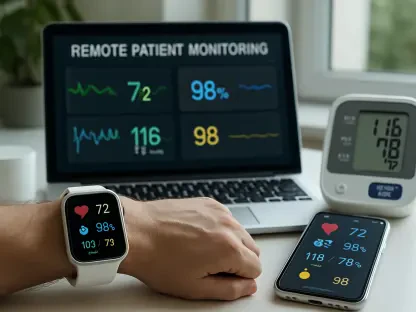Rapid advancements in AI-enabled wearables are reshaping healthcare paradigms, while India’s stock market showcases robust activity and positive trends. AI-enabled wearables, including devices like wristbands, patches, and smart clothing, are altering the landscape of healthcare with real-time monitoring capabilities. These devices track vital health parameters such as ECG, oxygen saturation, heart rate, and sleep quality around the clock. Collecting and analyzing this data offers personalized health insights that can optimize individual care plans, enhancing health outcomes and contributing to a more proactive healthcare environment.
Revolutionizing Healthcare with AI Wearables
AI-enabled wearables empower users by offering continuous monitoring and real-time health feedback. For instance, devices equipped with ECG sensors can detect irregular heart rhythms, which may indicate conditions like atrial fibrillation. This early detection can prevent serious complications, including strokes. Furthermore, continuous glucose monitors (CGMs) for diabetics enable real-time blood sugar management, significantly enhancing quality of life and reducing health risks. The personalized data collected can help individuals tailor their lifestyle choices, medications, and diet to better manage their conditions.The integration of AI in these devices allows for the collection and synthesis of data from various sensors, leading to more personalized and efficient treatment regimens. Wearables can recommend specific medications, supplements, and lifestyle changes based on individual health data, facilitating a tailored approach to health management. Moreover, these devices are not confined to chronic disease management; they are increasingly being used for preventive health measures, aiding in early diagnosis and improving patient compliance with their treatment plans.
Specialized Wearable Devices
The market for AI-enabled wearables is expanding to include specialized devices for distinct health needs. Fertility tracking bracelets and disposable abdominal patches for maternal health are prime examples. These specialized wearables cater to niche user requirements, offering detailed insights into specific health metrics relevant to their conditions. These innovations are backed by comprehensive research that shows how targeted health management tools can effectively address particular health challenges, leading to better outcomes and overall well-being.Wearable technology’s potential to detect life-threatening conditions extends to devices with accelerometers that can detect falls, a major risk for the elderly. By providing immediate alerts, these devices ensure rapid response to emergencies, potentially saving lives. The data gathered from these wearables can also contribute to broader public health research, offering aggregated insights that inform public health policies and interventions. By collecting anonymized data on a large scale, researchers can identify health trends and gaps in healthcare delivery, ushering in a new era of data-driven public health initiatives.
Chronic Disease Management
Chronic diseases, such as diabetes and hypertension, greatly benefit from AI-enabled wearables. Continuous glucose monitors (CGMs) facilitate non-stop blood sugar tracking, allowing for better management and fewer health complications. Similarly, wearable blood pressure monitors provide continuous data, enabling better management of hypertension with real-time insights. These wearables dramatically alter the traditional treatment model, which often relies on periodic check-ups and manual health tracking, allowing for real-time adjustments to treatment regimens based on continuous data.AI-enabled apps supporting these devices assist users in making informed decisions about diet, exercise, and medication. The shift from episodic to continuous monitoring empowers individuals with chronic conditions to take proactive steps in managing their health, thus improving overall quality of life. Real-time data allows for timely intervention and supports adherence to treatment protocols, ultimately reducing the risk of severe complications and hospitalizations. These technological advancements underscore a patient-centric approach, which empowers individuals to engage actively in their own health management.
Public Health Contributions
Beyond individual health management, AI-enabled wearables can significantly impact public health. Aggregated and anonymized data from millions of wearable users can reveal broad health trends and enable timely public health responses to issues like pandemics or outbreaks. These large datasets help craft targeted public health interventions and monitor the efficiency of ongoing initiatives. For example, during a pandemic, data from wearables can help track the spread of the virus, identify hotspots, and evaluate the effectiveness of containment measures in real time.The influence of wearables extends to the health insurance sector, where data-driven insights can lead to personalized insurance policies. Healthier behaviors tracked by wearables might result in policy discounts, encouraging users to maintain better health metrics. Insurance companies can utilize this data to develop risk profiles and predictive models that ensure more accurate premium calculations and encourage healthier lifestyles. This symbiosis between technology and insurance not only benefits individual users but also enhances the sustainability of healthcare systems by promoting preventive care.
Voice AI and Future Integrations
The synergy between AI-enabled wearables and voice AI assistants represents the future of healthcare technology. Voice assistants can analyze data collected by wearables to detect potential health issues early. This combination paves the way for proactive health management, moving from reactive treatments to preventive care. For instance, a voice assistant could use data from a wearable to alert the user about irregular health patterns and suggest early consultations with healthcare professionals, potentially preventing severe health crises.Technological integration extends to various aspects of health monitoring, enabling seamless data exchange between devices and healthcare providers. This real-time data flow ensures that individuals receive timely medical attention and accurate health assessments, promoting an overall healthier lifestyle. As technology advances, the integration of AI-enabled wearables with electronic health records (EHRs) can further streamline healthcare delivery, offering holistic and well-coordinated care. This closed-loop of continuous monitoring, data analysis, and personalized feedback could set new standards in healthcare, emphasizing prevention, precision, and personalization.
Stock Market Overview and Trends in India
India’s stock market is demonstrating noteworthy trends with both the National Stock Exchange (NSE) and Bombay Stock Exchange (BSE) showing positive activity across various indices. Key indices like Nifty 50 and Sensex have recorded increases, reflecting investor confidence and economic resilience. This trend shows that despite global uncertainties, India’s financial markets remain stable and vibrant, attracting both domestic and international investors.The Nifty IT index, in particular, saw a considerable rise, highlighting robust performance in the technology sector. This surge is indicative of the increasing prominence of tech stocks and their substantial contribution to the market’s overall growth. The technology sector’s performance is a testament to India’s burgeoning startup ecosystem and the increasing adoption of digital technologies across industries. The impressive gains in tech stocks underline the sector’s resilience and potential for future growth, buoyed by innovations and advancements in areas such as AI, machine learning, and digital transformation.
Top Performers and Losers in the Stock Market
Recent trading sessions have identified top gainers and losers within the NSE and BSE. Tech Mahindra, Wipro, and Bajaj Finance emerged as top gainers on the NSE, while Garden Reach and PolicyBazaar led gains on the BSE. These stocks’ performance underscores investor optimism in certain sectors, while the drop in companies like NTPC on the NSE and Motilal Oswal on the BSE suggests a shift in market sentiment in specific industries. The overall trend reflects a dynamic market environment where sectoral rotations and performance fluctuations are influenced by various economic and geopolitical factors.Investors remain attentive to sector-specific developments, with the IT and Auto sectors recording notable gains. This sectoral performance indicates a growing interest in technology and automotive innovation, aligning with broader global trends favoring advancements in these fields. For example, the resurgence of the auto sector could be attributed to increasing demand for electric vehicles and new automotive technologies. On the other hand, the IT sector continues to benefit from the strong demand for digital solutions and the growing importance of technology in business operations.
Commodity Prices and Volume Trends
Rapid advancements in AI-enabled wearables are significantly transforming healthcare paradigms. Devices such as wristbands, patches, and smart clothing have introduced real-time monitoring capabilities that are revolutionizing the way health is managed. These cutting-edge gadgets continuously track vital health parameters, including ECG, oxygen saturation, heart rate, and sleep quality, providing constant and precise monitoring.The data collected from these devices is analyzed to offer personalized health insights. This analytical capability allows for the optimization of individual care plans, contributing to better health outcomes. By providing a comprehensive, real-time overview of a person’s health, AI-enabled wearables enable more proactive and preventive healthcare measures. This leads to the earlier detection of potential health issues, timely interventions, and more tailored treatment plans, ultimately enhancing patient care and well-being.Simultaneously, India’s stock market is showcasing robust activity and positive trends. This activity is indicative of broader confidence in the market and suggests that economic factors are aligned favorably. Both sectors—healthcare through AI-enabled wearables and financial markets—are experiencing significant growth and innovation, reflecting a rapidly evolving landscape that embraces technology and data-driven decision-making.









